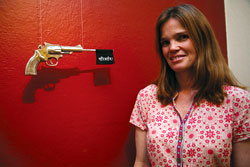|
|
The work that gives its title to the exhibition, 'Splatter Analysis', is a good starting point to unpacking the messages of the show: a large, mirror-smooth white board is drilled through to create a delicate pattern, but it is in fact the mark of random firing of an air defence system.
The beauty of the painting is in stark contrast to the reality of the weapon whose operation gives it its form. 'Splatter Analysis' sets the tone for the rest of the exhibition, highlighting the brutality of war by subverting its reality and transforming it into something aesthetically pleasing. The effect is unsettling.
The first piece that catches the eye on entering the gallery is a screen print of Birendra. If you squint it could be a Warholesque representation of John F Kennedy, driving in his open car, with obvious connotations. It is overpainted on aluminium, giving it a mirror-like aspect, only with no reflection, just a sense of unreality. Hanging opposite it in the room is a portrait of a young Pushpa Kamal Dahal in which the blend of aluminium background with black overlay gives an odd hint of the Shroud of Turin.
In between these two pieces, which both provoke a double take, is a hanging dress, the shape of which suggests a 1960s mini-skirt. Closer examination shows that it is made of camouflage cloth and is, as the guide sheet reveals, a reproduction of a17th century Tibetan suit of armour.
The overall impression, despite the beauty of the individual pieces, is of unease. It stems from the contradiction of aesthetic pleasure with the death-theme on many levels. Materials are used that are not so much unrelated as antithetical, glitter and stealth being the obvious example. Further disorientation comes from the inclusion of cultural and visual references from Africa and Europe in an exhibition that begins and ends with Nepal but refuses to let you settle into the comfort of a one country theme. Indeed, the stealth bomber and the other ultra-modern weapons depicted are an ironic reminder of the relief that the Nepali war remained relatively low-tech apart from a few notable examples.
The overwhelming effect of this collection of beautifully crafted references to brutality, is to remind the visitor of the banality of violence, how it happens in apparently 'normal', everyday contexts. It is resonant of the mid-19th century British poet, WH Auden, who writes of the myth of the fall of Icarus as he flies too close to the sun, pointing out that 'dogs go on with their doggy life and the torturer's horse scratches his innocent behind on a tree'.
John Bevan
Splatter Analysis is an exhibition of 22 pieces by UK artist Loren Beven and is showing at the Siddhartha Gallery , Babar Mahal Revisited until 23 April.



